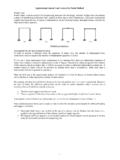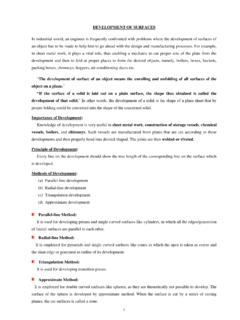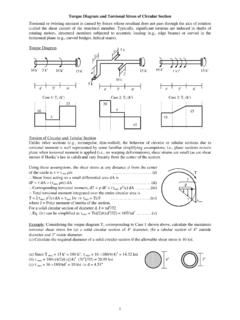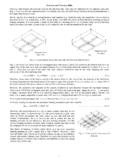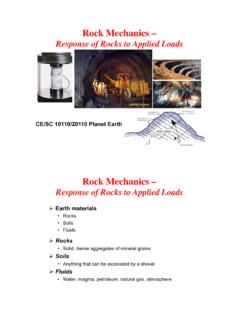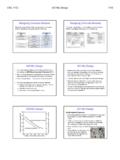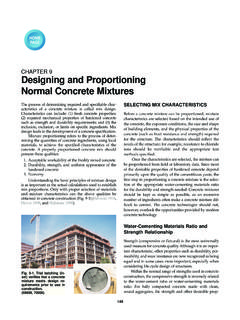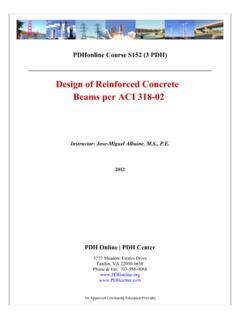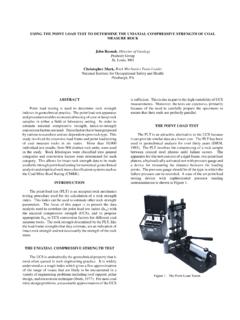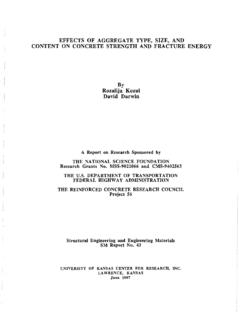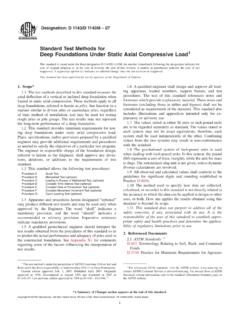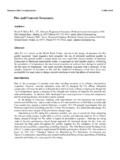Transcription of Mechanical Properties of Concrete and Steel - uap-bd.edu
1 1 Mechanical Properties of Concrete and Steel Reinforced Concrete (RC, also called RCC for Reinforced Cement Concrete ) is a widely used construction material in many parts the world. Due to the ready availability of its constituent materials, the strength and economy it provides and the flexibility of its forms, RC is often preferred to Steel , masonry or timber in building structures. From a structural analysis and design point of view, RC is a complex composite material. It provides a unique coupling of two materials ( Concrete , Steel ) with entirely different Mechanical Properties .
2 Stress-Strain Curve for Concrete Concrete is much stronger in compression than in tension (tensile strength is of the order of one-tenth of compressive strength ). While its tensile stress-strain relationship is almost linear [Fig. (i)], the stress ( ) vs. strain ( ) relationship in compression is nonlinear. Fig. (ii) shows a typical set of such curves. The tensile strength as well as the modulus of elasticity of Concrete are both proportional to the square-root of its ultimate strength , fc , and can be approximated by ft = 6 fc.
3 ( ), Ec = 57500 fc ..( ) [in psi]. For example, if fc = 3000 psi, ft 6 (3000) = 330 psi, and Ec 57500 (3000) = 106 psi Stress-Strain Curve for Steel Steel is linearly elastic up to a certain stress (called the proportional limit, fp) after which it reaches yield point (fy) where the stress remains almost constant despite changes in strain. Beyond fy, the stress increases again with strain (strain hardening) up to the maximum stress (ultimate strength , fult) when it decreases until failure at a stress (fbrk) quite close to fy.
4 The typical stress-strain curves for structural Steel are shown in Fig. (i), which also demonstrate the decreasing ductility of higher- strength Steel due to the vanishing yield region. However, the modulus of elasticity (Es) remains almost constant (Es 29000 ksi) irrespective of strength . The elastic-perfectly-plastic (EPP) model for Steel [Fig. (ii)] assumes the stress to vary linearly with strain up to yield point (fy) and remain constant beyond that. The available bar sizes available in the market are designated by diameters proportional to 1/8-in or millimeters and have the following areas (calculated from As = d2/4).
5 D (No.) 2 3 4 5 6 7 8 9 10 As (in2) d (mm) 8 10 12 16 19 22 25 28 31 As (in2) These curves are different for various ultimate strengths of Concrete , particularly the peak stress and ultimate strain. They consist of an initial relatively elastic portion in which stress and strain are closely proportional, then begin to curve to the horizontal, reaching maximum stress, , the compressive strength fc , at a strain of approximately , and finally show a descending branch.
6 They also show that Concrete of lower strength are more ductile; , fail at higher strains. Stress Strain, Stress Strain, fc Fig. : - curves of Concrete in (i) tension, (ii) compression fbrk fp p fyu fyl fult Fig. : (i) - curves of Steel (ii) EPP Model fy p 2 Reinforced Concrete subjected to Axial Force As Reinforced Concrete (RC) is a complex composite, its structural analysis and design is somewhat different from homogeneous sections. This is valid if it is subjected to axial force (compression/tension) or bending moment.
7 Axial Compression When axial ( compressive ) force is applied, the compressive strain is the same over the entire cross-section and in view of the bonding between Concrete and Steel , is the same in the two materials. Both Concrete and Steel behave nearly elastically at low stresses; , which are proportional to strain (corresponding to Concrete strain of ~ and Steel strain of ~ ). Since the stains are equal at a particular point, c = fc/Ec is equal to s = fs/Es fs = (Es/Ec) fc = n fc.
8 ( ) where n = Es/Ec, is called the modular ratio. If As = Area of reinforcing bars, Ac = Net area of Concrete ; , gross area minus As, Pc = Axial ( compressive ) load Pc = fc Ac + fs As= fc (Ac + n As) = fc [Ag+ (n 1) As] ..( ) To use the basic equations of equilibrium, the structural analysis of RC sections assumes them to be made of a homogeneous material. Instead of changing the modulus of elasticity over the section, the width of various parts is modified proportionately.
9 The stress analysis is made of an Equivalent or Transformed Section. Such an analogy cannot be drawn if the Concrete exceeds its elastic limit. However, one quantity of particular interest to the structural designer is the ultimate strength , the maximum load which the structure or member will carry. Tests (at different loading conditions and rates) have shown that Concrete and Steel can be assumed to carry maximum stresses of and fy under all circumstances. So the ultimate (nominal) load that the member can safely carry is Pn = Ac + fy As.
10 ( ) Axial Tension When the tensile force on a member is small enough for the stress in Concrete to be considerably below its tensile strength (ft ), both Concrete and Steel behave elastically. In this situation, all the expressions derived for compression are also valid for tension. In particular, the axial force Pc in the earlier equations is now replaced by Pt; , Pt = ft [Ag+ (n 1) As] ..( ) However, when the load is further increased, Concrete reaches its tensile strength and ceases to resist any part of the applied tensile force.


